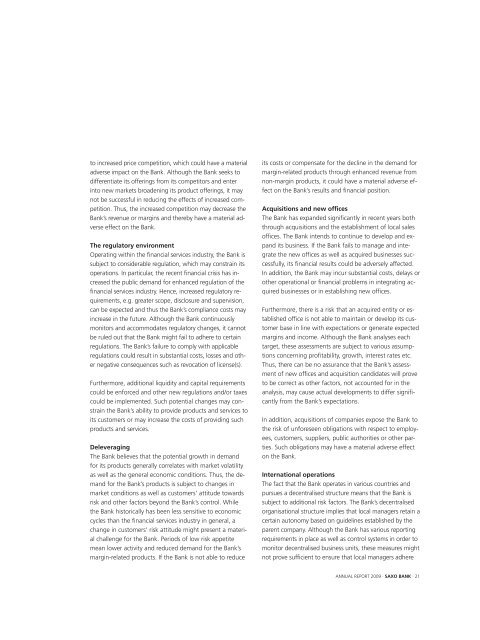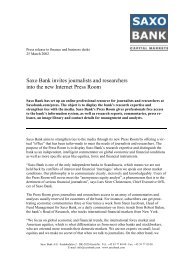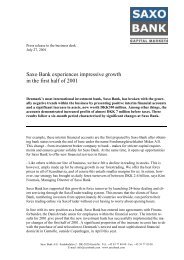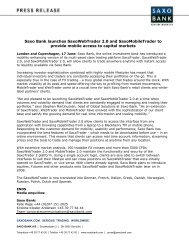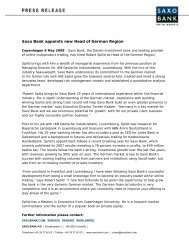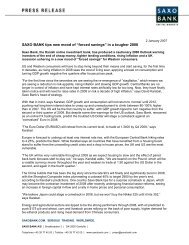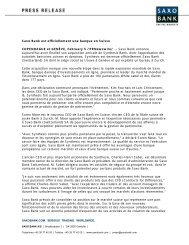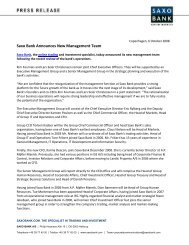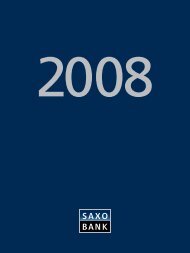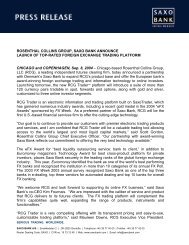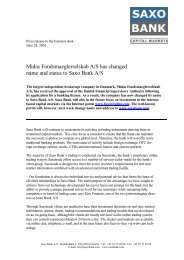Untitled - Saxo World
Untitled - Saxo World
Untitled - Saxo World
You also want an ePaper? Increase the reach of your titles
YUMPU automatically turns print PDFs into web optimized ePapers that Google loves.
to increased price competition, which could have a materialadverse impact on the Bank. Although the Bank seeks todifferentiate its offerings from its competitors and enterinto new markets broadening its product offerings, it maynot be successful in reducing the effects of increased competition.Thus, the increased competition may decrease theBank’s revenue or margins and thereby have a material adverseeffect on the Bank.The regulatory environmentOperating within the financial services industry, the Bank issubject to considerable regulation, which may constrain itsoperations. In particular, the recent financial crisis has increasedthe public demand for enhanced regulation of thefinancial services industry. Hence, increased regulatory requirements,e.g. greater scope, disclosure and supervision,can be expected and thus the Bank’s compliance costs mayincrease in the future. Although the Bank continuouslymonitors and accommodates regulatory changes, it cannotbe ruled out that the Bank might fail to adhere to certainregulations. The Bank’s failure to comply with applicableregulations could result in substantial costs, losses and othernegative consequences such as revocation of license(s).Furthermore, additional liquidity and capital requirementscould be enforced and other new regulations and/or taxescould be implemented. Such potential changes may constrainthe Bank’s ability to provide products and services toits customers or may increase the costs of providing suchproducts and services.DeleveragingThe Bank believes that the potential growth in demandfor its products generally correlates with market volatilityas well as the general economic conditions. Thus, the demandfor the Bank’s products is subject to changes inmarket conditions as well as customers’ attitude towardsrisk and other factors beyond the Bank’s control. Whilethe Bank historically has been less sensitive to economiccycles than the financial services industry in general, achange in customers’ risk attitude might present a materialchallenge for the Bank. Periods of low risk appetitemean lower activity and reduced demand for the Bank’smargin-related products. If the Bank is not able to reduceits costs or compensate for the decline in the demand formargin-related products through enhanced revenue fromnon-margin products, it could have a material adverse effecton the Bank’s results and financial position.Acquisitions and new officesThe Bank has expanded significantly in recent years boththrough acquisitions and the establishment of local salesof fices. The Bank intends to continue to develop and expandits business. If the Bank fails to manage and integratethe new offices as well as acquired businesses successfully,its financial results could be adversely affected.In addition, the Bank may incur substantial costs, delays orother operational or financial problems in integrating acquiredbusinesses or in establishing new offices.Furthermore, there is a risk that an acquired entity or establishedoffice is not able to maintain or develop its customerbase in line with expectations or generate expectedmargins and income. Although the Bank analyses eachtarget, these assessments are subject to various assumptionsconcerning profitability, growth, interest rates etc.Thus, there can be no assurance that the Bank’s assessmentof new offices and acquisition candidates will proveto be correct as other factors, not accounted for in theanalysis, may cause actual developments to differ significantlyfrom the Bank’s expectations.In addition, acquisitions of companies expose the Bank tothe risk of unforeseen obligations with respect to employees,customers, suppliers, public authorities or other parties.Such obligations may have a material adverse effecton the Bank.International operationsThe fact that the Bank operates in various countries andpursues a decentralised structure means that the Bank issubject to additional risk factors. The Bank’s decentralisedorganisational structure implies that local managers retain acertain autonomy based on guidelines established by theparent company. Although the Bank has various reportingrequirements in place as well as control systems in order tomonitor decentralised business units, these measures mightnot prove sufficient to ensure that local managers adhereANNUAL REPORT 2009 · SAXO BANK · 21


